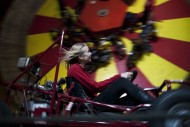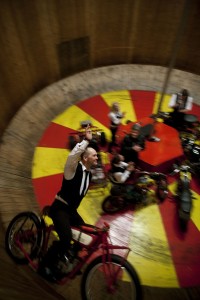Wall of Death or Way of Life?
By Thom Dibdin
When you call your show the Wall of Death and open it on a Friday night in Glasgow, you’d have to expect the cast of Taggart to turn up en masse, on the lookout for a Murrderr.
In fact, nothing of the sort happened at the SECC last night – at least not a killing spree. Not even when the cast of River City trotted over the wibbly wobbly bridge from the BBC to join them for the first night of the latest production from the National Theatre of Scotland.
Mind you, for all the NTS’s grand designs to look out to the world by both bringing the best of theatre to Scotland and showing the best of Scottish Theatre to the world, planet Scottish soap is a relatively small and insular place. And despite the provision of hot dogs, bottles of Bud (offered with a suitable apology) and the obligatory opening night party plonk, neither cast was making much of an effort to mingle with the other in the post-show shindig.
At least they made the effort to turn up. Culture Minister Fiona Hyslop had given her ticket to a young member of the Culture Office – who seemed to have enjoyed the wall of death, if not the theatrical framework in which it was placed. Somewhat alarmed to find himself chatting happily away about the next step towards Creative Scotland – “I’m not paid enough to speak to a journalist!” – he was relieved when the chat turned to Pure and the Venue.
The show itself was something of a strange affair, and marks the next step on NTS Artistic Director Vicky Featherstone’s journey to redefine the limits of the theatrical experience. Having put a Shetland ceilidh band on the stage to celebrate the story of a forgotten Island musician in Long Gone Lonesome, she has now turned to the Carney tradition and created a piece of work that celebrates the family who create the side-show as well as the side-show itself.
In many ways, it is akin a whole slew of plays in the late 1990s which tried to find a theatrical expression of hedonistic night-clubs – like Pure, which ran at the now-defunct Edinburgh Venue for a good decade – by writing site-specific pieces which had a night-club setting. So the young man from the Culture Office wasn’t so far off the mark.
There’s something about the raw power of the Wall of Death that is as thrilling as any pumped-up piece of techno music. Instead of the thud of bass, there’s the boom of the engines and the thud of tyres around the tight wooden circular wall. Instead of dry ice, the stench of petrol exhaust fills your nostrils. Your eyes flare at the riders’ daredevil exploits, not the DJ’s expansive mixes. And the rush of adrenaline as the motorbikes rise up the wall to twist and turn just below where your head is keeking over the side, is as exciting as any big beat breakdown.
What Featherstone’s piece doesn’t do is try and impose the normal rules of theatre on a show which is inherently theatrical enough in itself. She might have got visual artist Stephen Skrynka to collaborate with the the world-famous Ken Fox Troupe. But there never was going to be a murder here. Or, indeed, any of the theatrical devices employed by the less successful of those 1990s night-club shows. Not even a Murrderr.
I was there reviewing for The Stage and will post the review here when it is up on the Stage website. It was a bit of a family occasion for me too – the wee brother had done the photography job for the show. And pretty impressive his pics are too.
Wall of Death: A Way of Life is at the SECC, Glasgow until February 12, at the Aberdeen Exhibition and Conference Centre from the 15th to 17th and – finally – on an Edinburgh stage at the Royal Highland Centre from the 20th to the 28th of February.
Comments (2)
Trackback URL | Comments RSS Feed
Sites That Link to this Post
- Theatre Review – Wall of Death: A Way of Life | Feb 24 2010























Very good!I didnt see the cast of Taggart but the wall of death was very scary~and good